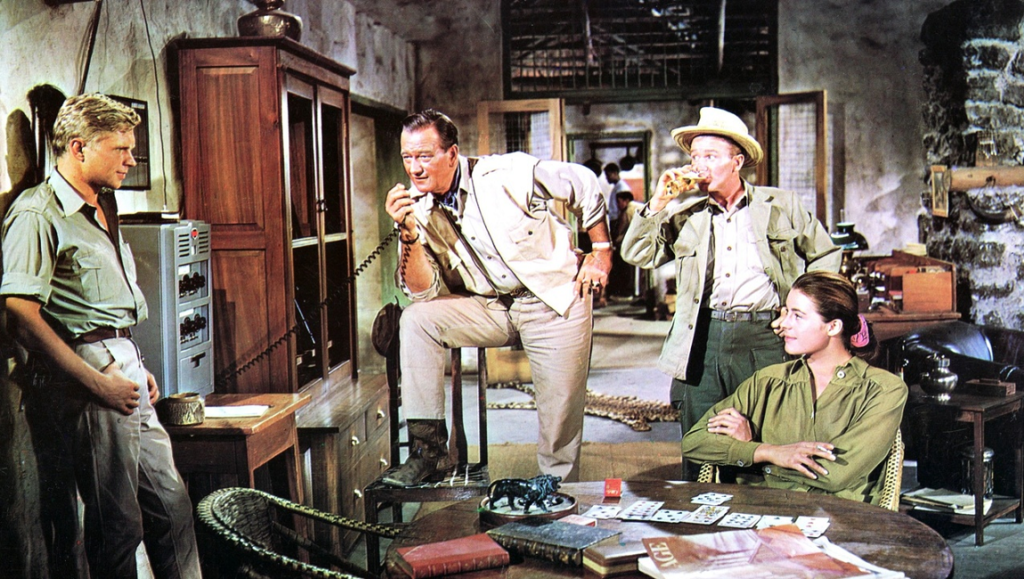Artist and critic Fred Camper once called Howard Hawks (and I’m paraphrasing from memory here) the “hardest to define of all the classic Hollywood auteurs, an artist whose sensibility was built around gestures, movements, and hands rather than more obvious kinds of stylization.” It’s easy to see what he means; Hawks’ best films revel in a certain kind of laidback communal atmosphere, mostly content to examine casual group dynamics as different personality types bounce off of — and sometimes crash into — one another. Robin Wood suggests that “[Hawks’] profundity lies in the concrete realization of his art and is always firmly rooted in the practicalities of relationships and behaviour.” Indeed, much Hawks scholarship has busied itself with identifying and quantifying this group dynamic across any number of films; Peter Wollen’s famous Signs and Meanings in the Cinema is the earliest instance I can find of a critic applying structuralist ideas to Hawks, in which Wollen constructs a detailed taxonomy that compares and contrasts the “adventure” films (Rio Bravo, Only Angels Have Wings, Hatari!, etc.) with the “comedies” (His Girl Friday, Twentieth Century, Monkey Business, etc.). In what is perhaps an instance of friendly one-upmanship, Robin Wood would subsequently blur and modify these distinctions, correctly noting that many of the comedies take on attributes of the adventure films, and vice versa. But one common denominator remains, and that is Hawks’ frequent return to ritualized initiations, rites of passage that find an outsider (usually a woman) proving their worth to the group and then being accepted into it.
Filmmaker Dan Sallitt has written about Hawks’ “late” films, i.e. the five features he made after Rio Bravo (generally considered his last masterpiece, except by hardcore auteurists who know better). Sallitt suggests that an artist’s “late period” would typically follow a “success” of sorts, which would allow the filmmakers to “proceed to projects that are, on the surface, very like the previous successful projects — but, beneath the superficial resemblances, the new films are more self-enclosed, more self-consciously stamped with the filmmakers’ personalities, less of a compromise between movie-movies and personal quirk.” This is as fine a description of Hatari! as one is likely to find, an offbeat adventure film with only a few (dynamite) action scenes, an aged leading man in John Wayne, a leisurely 157-minute runtime, and ample amounts of singing, pageantry, and even cute baby animal comedy routines. Indeed, the film frequently feels attuned to Wayne’s specific physicality, his unique aged rhythms — a little slower and a little less agile, but still tough when and where it counts. Here he plays Sean Mercer, leader of a group of big game hunters ensconced in Africa who catch rather than kill their quarry, shipping them off to zoos around the globe. His group is a motley assortment of character types; there’s a former racecar driver, Kurt Muller (Hardy Krüger); a bullfighter named Luis Francisco Garcia Lopez (Valentin de Vargas); a sharpshooter named Little Wolf, also frequently referred to bluntly as “The Indian” (Bruce Cabot); and a former NYC cabbie they call “Pockets” (Red Buttons). When Little Wolf gets gored by a rhino during a hunt, the group must get him to the only nearby city with a hospital, where they wind up meeting a Frenchman called “Chips” (Gérard Blain). He wants to join the group, replacing the injured Little Wolf, but winds up butting heads with Kurt. Eventually, Chips helps Little Wolf by offering himself up as a donor for a blood transfusion, an act of generosity that essentially grants him (tentative) access to the team. Returning to their home base in the wilderness, the men meet a photographer named Dallas (Elsa Martinelli) who has been sent from a Swiss zoo to document their work. The men all quickly fall head-over-heels for the attractive woman, except for stoic Sean. It goes virtually without saying that Dallas will eventually wind up with him, but the pleasures here are all in the ebb and flow of the characters and their interactions. As Sallitt suggests, Hatari! is full of variations of key Hawksian motifs; Chips and Kurt start off as rivals, even re-enacting the shooting scene from Red River, where their distaste for one another dissolves into mutual respect for the other’s skills. Dallas’ courtship of Sean very much mirrors the burgeoning romance between Feathers (Angie Dickinson) and Wayne’s John T. Chance in Rio Bravo. And the casual acceptance of potential injury and/or death in Hatari! is imported wholesale from Only Angels Have Wings, although the former is much lighter in its existentialism than the later.
Todd McCarthy’s exhaustive Hawks biography The Grey Fox of Hollywood details the production of Hatari!: how after the success of Rio Bravo, Hawks decided to cash in his newfound power at the studio by finally realizing this long-gestating passion project; the ups and downs of writing an actual screenplay, which Hawks self-consciously peppered with elements from prior successes; the beginning of principal photography with no actual screenplay in hand; and Hawks’ stated desire that the production should be “like a vacation.” McCarthy mentions Truffaut and the idea that Hatari! is in fact a thinly-veiled depiction of filmmaking, essentially a document of its own making, with Hawks the benevolent leader. The film was ultimately a financial disappointment, but that’s of no concern now, 60 years later. It remains one of Hawks’ loosest confections, a genial, charming bit of camaraderie that ambles along, content to be itself. It’s not a masterpiece, not exactly, but it is one of Hawks’ greatest achievements.
Part of Kicking the Canon – The Film Canon.


Comments are closed.